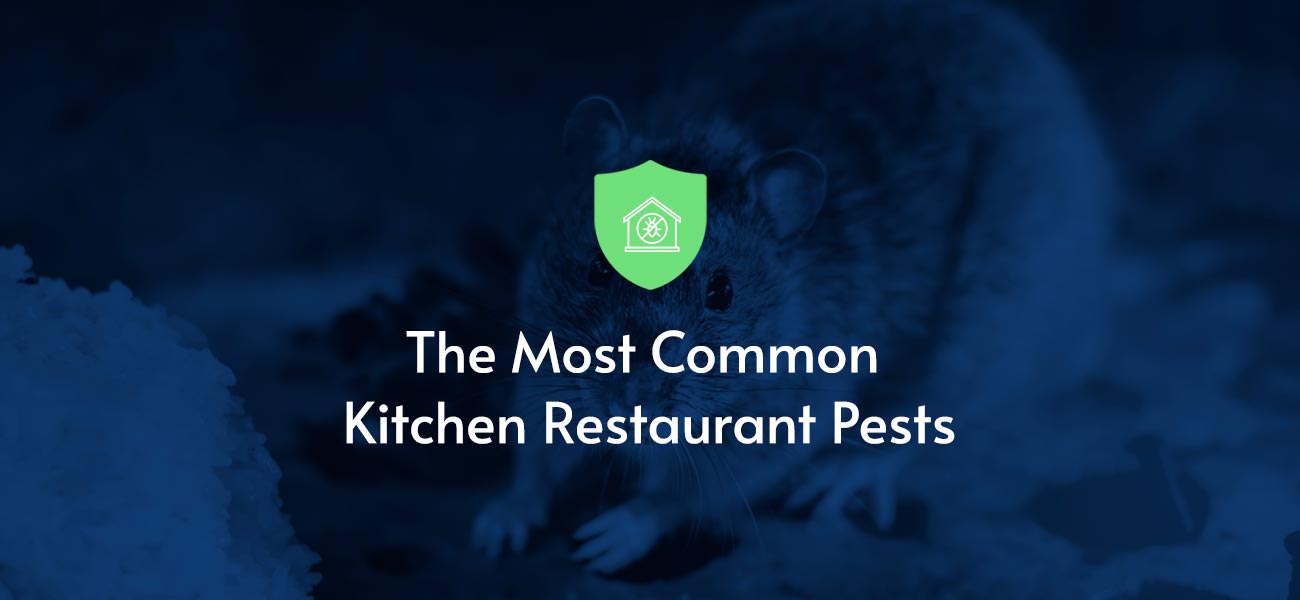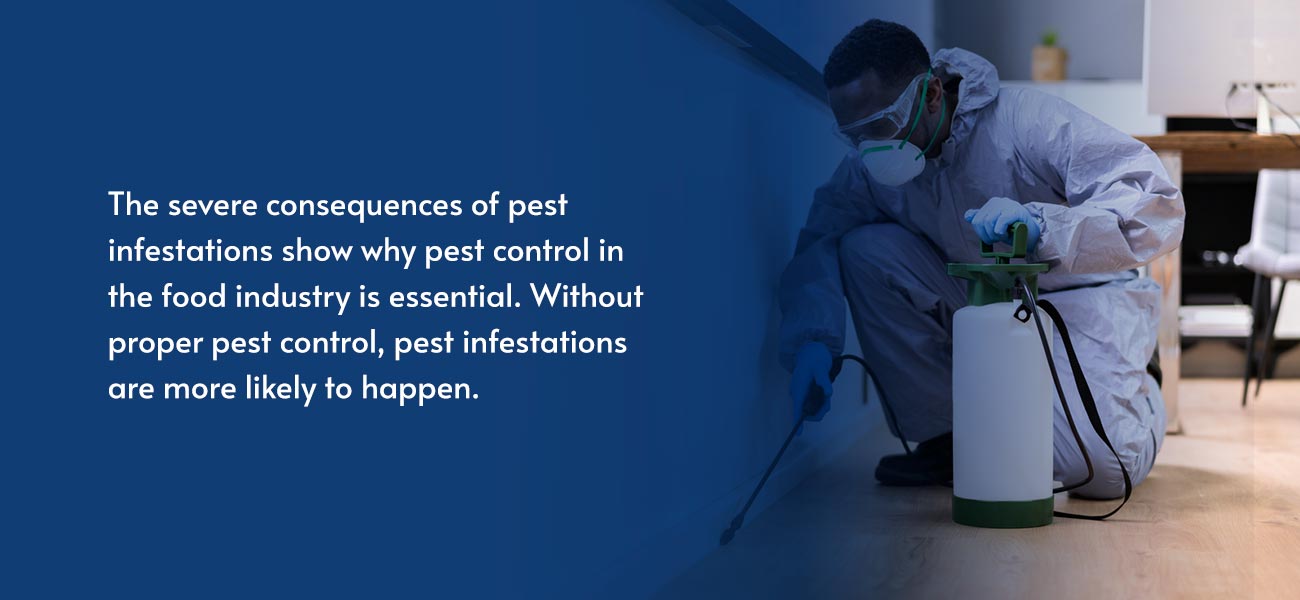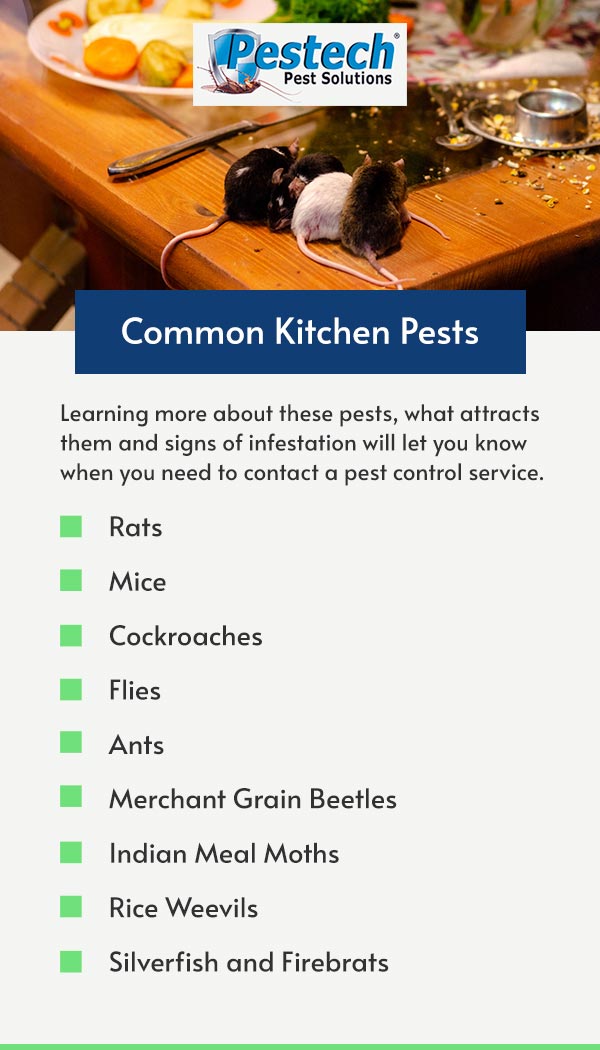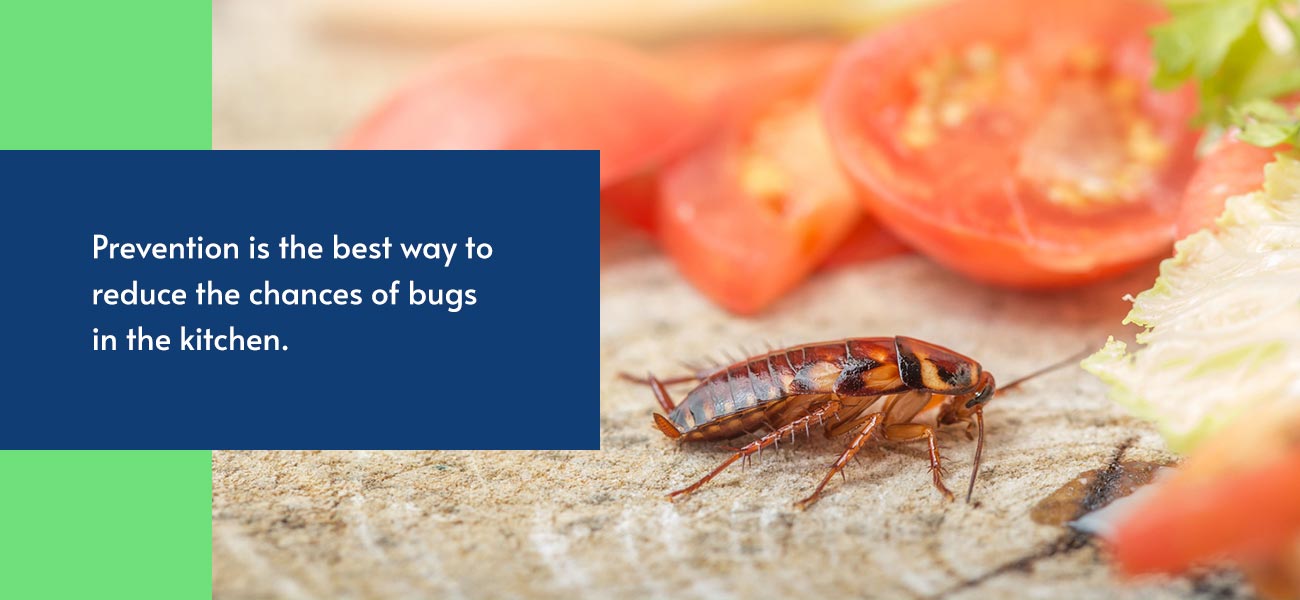The Most Common Kitchen Restaurant Pests

Pests are attracted to food, making your restaurant an ideal place for them to want to be. New York has over 90,000 food service establishments that offer plenty of stored and spilled food for insects and rodents. It’s necessary to take precautions and prevent pests before they multiply.
Pests can pose serious health risks to restaurant employees and guests and cause financial loss. If your restaurant experiences a pest infestation, you will lose customers and may close temporarily or permanently. Your reputation may never be able to recover. The best way to prevent an infestation is with routine pest control services and thorough sanitation and hygiene practices. This guide will review why pest control in the food industry is important, common kitchen pests, signs of infestation and what you can do to prevent it.

Why Pest Control in the Food Industry Is Important
Pests are more than a simple nuisance. When they invade restaurants, they can:
- Spread disease: Various pests are known to cause health issues. For example, rodents can carry over 35 diseases, and cockroaches can trigger allergy and asthma symptoms.
- Damage property: Pests like to chew through things, such as wires, walls and food containers, which causes damage to your equipment and establishment.
- Contaminate food: Rodents and insects contaminate food and workstations, putting employees and customers at risk for health problems.
- Damage reputation: Word-of-mouth is one of the best advertisement methods in the restaurant industry. However, if a customer sees a cockroach in your restaurant, they will likely form a negative opinion about your establishment, which could spread around and cause you to lose customers. It can also cause the health inspector to show up at your door.
- Close business: If you don’t deal with a pest infestation properly, you will have to close your restaurant temporarily or permanently.
The severe consequences of pest infestations show why pest control in the food industry is essential. Without proper pest control, pest infestations are more likely to happen.

Common Kitchen Pests
Common kitchen pests include rats, mice, cockroaches, ants, beetles, moths, weevils and brats. As long as these pests have a food and water source and a nest, they can make themselves at home. Learning more about these pests, what attracts them and signs of infestation will let you know when you need to contact a pest control service.
Rats
Rats and mice are the most common pests in New York. These pests build nests close to their food source and come out at night to wreak havoc. Rats can damage electrical equipment, food containers, packaging and machinery. They breed quickly and transmit diseases, such as hantavirus pulmonary syndrome (HPS) and Leptospirosis.
Rats are the largest rodent and can grow almost 16 inches long. All rats have little ears and long, scaly flesh-like tails. They need about an ounce of food daily and two ounces of water. Commonly seen in winter, the top species of rats found in this area are:
- Norway rats: Norway rats tend to have two-tone fur varying from brown to gray, small ears and eyes and a blunted nose. They prefer to nest in burros they dig but will live in a building for a time. Norway rats eat almost anything and are attracted to garbage. They are cautious and shy away from new objects or environmental changes. The typical life span of a Norway rat is one year. It can have up to 12 offspring per litter, five times a year.
- Roof rats: The roof rat is similar to the Norway rat, but they have more prominent ears and a long tail and are typically gray-brown with a pale gray underside or black. Roof rats will gnaw and eat stored food. They like to explore their surroundings but can be frightened by new objects or environmental changes. They feed from dusk to dawn but can forage in groups during the day.
Mice
Mice are a lot like rats, but there are a few differences between them, including pest control methods. Compared to rats, mice have smaller bodies, hairy tails, more prominent ears, a pointier nose and a longer life span. Mice consume most of their water through food. They cause the same type of damage as rats and pose similar health risks. Common types of mice include:
- Deer mice: Deer mice and white-footed mice are very similar in appearance and behavior. They have two-tone fur with a darker back and a white underbelly. These mice like to burrow close to a food source in secluded ground-level cavities. They store gathered food in a nearby “larder” and are very attracted to seeds and grains.
- House mice: The house mouse’s body is uniformly colored. Their tails are only partially covered in fur and are as long as their bodies. The house mouse prefers grains and seeds but will also eat human food.
Cockroaches
As far as kitchen bug identification goes, cockroaches are known universally. The most common cockroach is the German cockroach. These cockroaches carry parasitic worms, bacteria and human pathogens and can cause allergic reactions or trigger asthma symptoms. Their legs pick up debris and transfer it as they travel through workstations, food and equipment. Their small size allows them to hide in cracks and crevices close to a food and water source.
Cockroaches have varied diets and will be able to survive almost anywhere. They love kitchens because of their warmth, humidity, excess moisture and food debris. Since they are nocturnal, there could be hundreds by the time you notice them.
Flies
You might view flies as harmless compared to other pests, but this is not the case. Flies are known to carry bacteria and spread diseases. Some species even regurgitate their digestive juices and defecate when resting and feeding. The most common types of flies in New York are:
- Fruit flies: Fruit flies are small with bright red eyes and tan or black bodies. They love the fermented odors of over-ripe fruits and vegetables, so they are most common in summer and fall.
- House flies: House flies are dull gray. They like garbage, food odors and decaying matter. You can commonly find them around dumpsters and trash cans, but they will rest on countertops and workstations, spreading diseases. They are dormant during the winter but come out during spring to lay eggs.
- Drain flies: These small flies look similar to moths and are closely related to fruit flies. They are attracted to decayed organic matter, so they are commonly found in or around drains and under cabinets and dirty floor mats.
- Phorid flies: Phorid flies are small and like decaying matter and grease. They hang around and breed at grease traps.
Ants
Odorous house ants — or sugar ants — are common in kitchens. They build their nests near a water source, like sinks or pipes. There are multiple queens, making it a challenge to control them. If you don’t treat them properly, they could build numerous nests.
Ants are capable of transmitting food-borne disease organisms and can contaminate food with pathogens. They also like to sting.
Merchant Grain Beetles
The Merchant Grain Beetle is a common stored-food pest that likes grain, fruit, tobacco and dried pantry goods. It is a slender, dark brown beetle that cannot fly. These beetles don’t sting or bite and are not known to carry and spread diseases to humans. Their danger lies in food contamination.
Indian Meal Moths
Indian meal moths love stored pantry food. The adult moth has whitish gray wings with copper on the forewing and will lay eggs in stored food. Smallish white larvae will hatch and feed on the food within a few days.
These pests don’t sting or bite and don’t pose a threat to health, but they contaminate food.
Rice Weevils
Rice weevils are dark brown bugs with light-colored patches on their wings, usually four. They breed quickly and can build up considerable populations in stored food. These pests love grain but will also feed on other dried goods. If disturbed, they will play dead by drawing their legs close to their bodies.
These bugs are not known to transmit diseases to humans, but they still contaminate food.
Silverfish and Firebrats
These bugs are wingless insects that enjoy sugars and starches. Silverfish are gray, blue or silver, while firebrats are gray-brown. They are nocturnal, so they hide during the day. Typically, they invade homes and businesses during the summer and can survive for months without nourishment.
Silverfish and firebrats cause damage and contaminate food, but they don’t spread diseases or bite.
Signs of Pest Infestation
When you suspect you have an infestation, there are usually signs you can look out for to confirm it. Here are common indications for the different types of infestation by pantry bugs.
Rodent
As with any infestation, you can look for signs to know when to call a pest management service for a rodent problem. These signs include:
- Holes: Rats and mice need an entry point into your business and will chew through anything in their way. Rats require about half an inch of space to enter and will make the hole larger later on. Mice only need a quarter inch of space.
- Chew marks: These rodents love to chew and do not cover their tracks. Both can chew through storage containers, electric wires, walls and insulation. They typically single out one food source and continue returning to it.
- Droppings: A rat leaves between 20-50 droppings per day, about 10-20mm in size, and a mouse produces 40-100 droppings per day. Mice also leave urine trails.
- Grease marks: These marks appear near or on cabinets and walls and are caused by greasy rodent fur.
Cockroach
As one of the most common kitchen bugs, cockroaches always leave signs behind when they invade your space. So, you can learn to notice their presence even if you don’t see one. Signs of a cockroach infestation include:
- Dark or golden smears along walls, floors, cabinets and countertops.
- An unpleasant, musty odor.
- Droppings that resemble coffee grounds or soil.
- Dead cockroach skins.
- Tiny chew marks.
- Egg capsules with 8-20 segments.
They like sticky, sugary food, excess moisture, grease, uncovered trash bins and improperly stored food. Ants carry and spread bacteria and diseases and contaminate food sources until they destroy them.
Insect
There are only a few signs of insect infestation, other than spotting them:
- Insects in sticky traps: You can lay out sticky traps and look for insects.
- Debris or damage: Debris or damage that looks like insects caused it.
- Body parts: Insect wings and other body parts, like an exoskeleton.
Merchant Grain Beetle
There are only a few signs of merchant grain beetle infestation:
- Spotting adult beetles in a food source: This is a good indicator that there’s a problem.
- Spotting larvae in a food source: They look like tiny white grubs with brown heads.
- Overheating grain: If the infestation is severe, the grain will overheat.
Indian Meal Moth
The visible signs that you have an Indian meal moth infestation are:
- Webbing: If you find webbing in a stored food product, it’s probably from Indian meal moths.
- Larvae: You may see little caterpillars.
- Frass: Frass is insect feces that look like a fine, gritty material.
Rice Weevil
Some signs of rice weevil infestation are:
- “Shot hole” appearance in grain or kernels.
- Heat at the grain surface.
- The presence of adult rice weevils.
Silverfish and Firebrat
The signs of silverfish and firebrat infestation are:
- Feeding marks: Holes, notches or etches on a surface.
- Yellow stains or scales: You will find these stains and scales in the affected area.
- Feces: It looks like tiny black pellets.

How to Prevent Kitchen Pests in Your Restaurant
Prevention is the best way to reduce the chances of bugs in the kitchen. Here are some things you can do to keep your kitchen unwelcoming to pests:
- Use pest control services regularly.
- Enforce strict hygiene and sanitation practices.
- Regularly clean and sanitize all surfaces.
- Remove all clutter.
- Place heavy equipment on rollers, so you can move them to clean.
- Clean all ventilation screens.
- Dispose of food waste properly.
- Empty trash bins regularly.
- Store food in pest-proof containers.
- Replace cracked tiles and seal gaps.
- Limit water sources by turning off faucets and fixing leaky pipes.
- Use window and door screens.
- Keep doors and windows closed when not in use.
- Install door sweeps on exterior doors.
- Inspect deliveries for decaying or rotting items and dispose of them immediately.
- Use a fan.
- Seal any entry points, such as holes or cracks.
Contact Pestech Today for Restaurant Pest Control Services
Pests pose serious health risks and financial loss to restaurants. When one finds its way in, it will quickly multiply, and the situation could grow out of control. Routine pest control services will prevent infestations.
Pestech is the largest family-owned pest management center in the state. We offer our clients a 100% satisfaction guarantee, so we will keep returning until there is no longer an infestation. If you want routine pest control services, but are concerned about the environmental impact, ask about our GreenPro Program.
Our green integrated pest management program uses low-environmental-impact mechanical pest removal methods and low-volatility methods to target and remove pests. Contact us today to schedule your inspection.

